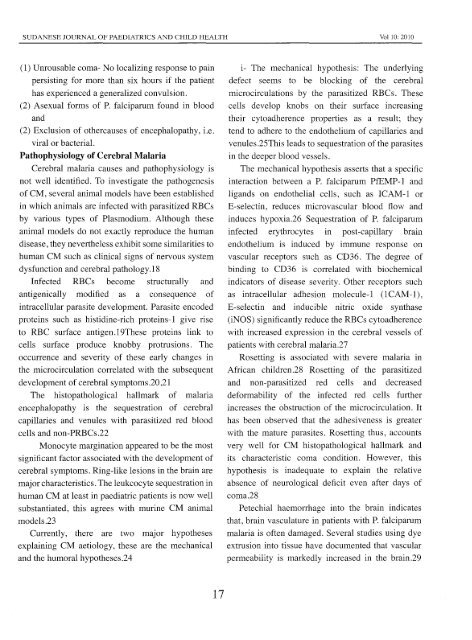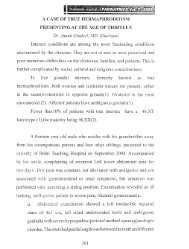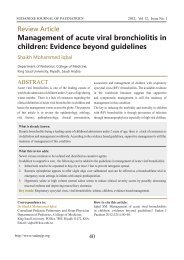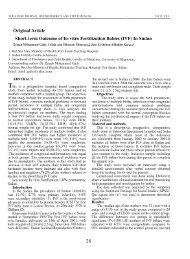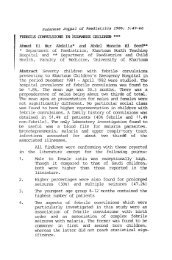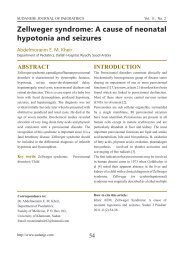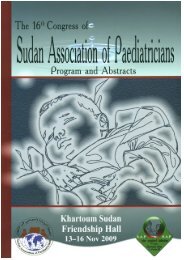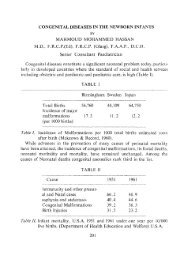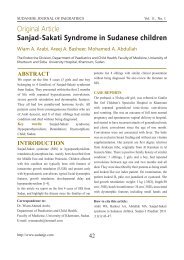Cerebral Malaria in Children: A Review of ... - Sudanjp.org
Cerebral Malaria in Children: A Review of ... - Sudanjp.org
Cerebral Malaria in Children: A Review of ... - Sudanjp.org
You also want an ePaper? Increase the reach of your titles
YUMPU automatically turns print PDFs into web optimized ePapers that Google loves.
SUDANESE JOURNAL OF PAEDIATRICS AND CHILD HEALTH VallO: 2010(1) Unrousable coma- No localiz<strong>in</strong>g response to pa<strong>in</strong>persist<strong>in</strong>ghas experiencedfor more than six hours if the patienta generalized convulsion.(2) Asexual forms <strong>of</strong> P. falciparum found <strong>in</strong> bloodand(2) Exclusion <strong>of</strong> othercauses <strong>of</strong> encephalopathy, i.e.viral or bacterial.Pathophysiology<strong>of</strong> <strong>Cerebral</strong> <strong>Malaria</strong><strong>Cerebral</strong> malaria causes and pathophysiology isnot well identified. To <strong>in</strong>vestigatethe pathogenesis<strong>of</strong> CM, several animal models have been established<strong>in</strong> which animals are <strong>in</strong>fected with parasitized RBCsby various types <strong>of</strong> Plasmodium. Although theseanimal models do not exactly reproducethe humandisease, they nevertheless exhibit some similarities tohuman CM such as cl<strong>in</strong>ical signs <strong>of</strong> nervous systemdysfunction and cerebral pathology. 18Infected RBCs become structurally andantigenic ally modified as a consequence <strong>of</strong><strong>in</strong>tracellular parasite development. Parasite encodedprote<strong>in</strong>s such as histid<strong>in</strong>e-rich prote<strong>in</strong>s-I give riseto RBC surface antigen.I9These prote<strong>in</strong>s l<strong>in</strong>k tocells surface produce knobby protrusions. Theoccurrence and severity <strong>of</strong> these early changes <strong>in</strong>the microcirculation correlated with the subsequentdevelopment <strong>of</strong> cerebral symptoms.20 ,21The histopathological hallmark <strong>of</strong> malariaencephalopathy is the sequestration <strong>of</strong> cerebralcapillaries and venules with parasitized red bloodcells and non-PRBCs.22Monocyte marg<strong>in</strong>ationappeared to be the mostsignificant factor associated with the developmentcerebral symptoms. R<strong>in</strong>g-like lesions <strong>in</strong> the bra<strong>in</strong> aremajor characteristics.<strong>of</strong>The leukcocyte sequestration <strong>in</strong>human CM at least <strong>in</strong> paediatric patients is now wellsubstantiated, this agrees with mur<strong>in</strong>e CM animalmodels.23Currently, there are two major hypothesesexpla<strong>in</strong><strong>in</strong>gCM aetiology, these are the mechanicaland the humoral hypotheses.24i- The mechanical hypothesis: The underly<strong>in</strong>gdefect seems to be block<strong>in</strong>g <strong>of</strong> the cerebralmicrocirculations by the parasitized RBCs. Thesecells develop knobs on their surface <strong>in</strong>creas<strong>in</strong>gtheir cytoadherence properties as a result; theytend to adhere to the endothelium <strong>of</strong> capillaries andvenules.25This<strong>in</strong> the deeper blood vessels.leads to sequestration <strong>of</strong> the parasitesThe mechanical hypothesis asserts that a specific<strong>in</strong>teraction between a P. falciparum PtEMP-I andligands on endothelial cells, such as ICAM-l orE-select<strong>in</strong>, reduces microvascular blood flow and<strong>in</strong>duces hypoxia.26 Sequestration <strong>of</strong> P. falciparum<strong>in</strong>fected erythrocytes III post-capillary bra<strong>in</strong>endothelium is <strong>in</strong>duced by immune response onvascular receptors such as CD36. The degree <strong>of</strong>b<strong>in</strong>d<strong>in</strong>g to CD36 is correlated with biochemical<strong>in</strong>dicators <strong>of</strong> disease severity. Other receptors suchas <strong>in</strong>tracellular adhesion molecule-I (l CAM -1),E-select<strong>in</strong> and <strong>in</strong>ducible nitric oxide synthase(iNOS) significantly reduce the RBCs cytoadherencewith <strong>in</strong>creased expressionpatients with cerebral malaria.27<strong>in</strong> the cerebral vessels <strong>of</strong>Rosett<strong>in</strong>g is associated with severe malaria <strong>in</strong>African children.28 Rosett<strong>in</strong>g <strong>of</strong> the parasitizedand non-parasitized red cells and decreaseddeformability <strong>of</strong> the <strong>in</strong>fected red cells further<strong>in</strong>creases the obstruction <strong>of</strong> the microcirculation. Ithas been observed that the adhesiveness is greaterwith the mature parasites. Rosett<strong>in</strong>g thus, accountsvery well for CM histopathological hallmark andits characteristic coma condition. However, thishypothesis is <strong>in</strong>adequate to expla<strong>in</strong> the relativeabsence <strong>of</strong> neurological deficit even after days <strong>of</strong>coma.28Petechial haemorrhage <strong>in</strong>to the bra<strong>in</strong> <strong>in</strong>dicatesthat, bra<strong>in</strong> vasculature<strong>in</strong> patients with P. falciparummalaria is <strong>of</strong>ten damaged. Several studies us<strong>in</strong>g dyeextrusion <strong>in</strong>to tissue have documentedthat vascularpermeability is markedly <strong>in</strong>creased <strong>in</strong> the bra<strong>in</strong>.2917


